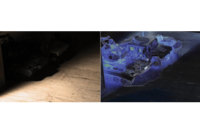So what if Jose Ruano and Steve Weatherly were “blown away,” in Weatherly’s own words, by megapixel cameras.
But that wasn’t really justification for a hard-nosed business decision when it came to a next generation of security video technology at the University of Miami, located in Coral Gables in south Florida.
Instead, Ruano, executive director of IT security, like other enterprise security leaders, walked through a series of realizations that lead to installation of more than 350 megapixel cameras throughout his main campus in order to create a safer environment for students, staff and visitors.
A private research university with more than 15,000 students, it comprises 12 schools and colleges serving undergraduate and graduate students in more than 180 majors and programs. While the university had maintained video surveillance for a number of years, Ruano says that, as with decentralized higher education institutions as well as corporations that grow, merge and acquire, “we had so many legacy analog systems” that “we were looking to bring it all together into a unified system that we could manage in a centralized manner.”
Too Many Myriad Systems
It turned out that campus police, responsible for monitoring video and investigating any incidents, had an additional and unwanted challenge when maneuvering among the many disparate systems.
In order to move to that single unified design, Ruano and colleague Weatherly, senior security engineer, knew there was need to upgrade to IP. “It was much more economical to upgrade our cameras and run them over the IP network than laying coax,” recalls Weatherly. Both men conducted extensive research and identified the top technology candidates with whom they wanted to conduct more extensive discussions. “When I first saw a demo of an IQeye megapixel camera, I was blown away at the quality compared to analog,” says Weatherly. But, it turned out that the decision to go megapixel was as much a matter of practical infrastructure and lower cost.
Those factors, on a decidedly larger scale, played a role when the Texas Department of Aging and Disability Services (DADS) elected to deploy 3,200 H.264 megapixel cameras at 336 of its DADS locations.
There was also the encouragement that came from the Texas Legislature which, in 2009, required that video surveillance equipment be installed in all DADS facilities to detect and prevent the exploitation or abuse of residents and clients.
According to Chris Hugman, vice president at Knight Security, the project’s integrator, the DADS installation, started in January 2010, uses IQinVision HD megapixel cameras, OnSSI video management software, network switches, and off-shelf servers to provide an interactive video monitoring interface. For the 12 separate campuses, housing multiple buildings, an end-to-end network infrastructure with 35 miles of fiber optic cable connects all the buildings together on each campus.
Cost Savings and Quality Images
The megapixel approach, adds Hugman, achieved the agency’s security goals, including high-quality images, while saving the state money in terms of number of cameras needed and in installation and long-term maintenance costs.
The DADS project is one of the largest, all-megapixel camera installations in the world. By going megapixel, DADS installed substantially fewer cameras compared to standard definition cameras, and still covered more area in each building. In so many ways, according to Hugman, “this was not a standard security operation.” A crucial need is “to monitor the quality of care.” When it comes to liability issues, forensics and the ability to zoom in on specific areas, such functionality plays a key role.
More generally, when an enterprise security leader works with his or her integrator, “you just have to pick the right camera for the right shot at the right location,” Hugman adds. And select the right video management platform at the start, one that more easily can scale up as the number of megapixel cameras grow.
It’s also an ever changing environment at the University of Miami.
The university has more than 400 cameras installed and approximately 90 percent of them are megapixels, often placed where image quality is critical for identification purposes such as in parking lots and areas that typically have a high density of students. Campus police conduct regular auditing to identify so-called high crime areas. Cameras are then moved or new ones installed to address these more pressing needs.
Megapixel cameras are catching on worldwide due to a number of factors, including the need for higher quality images for real-time monitoring and forensics; but the biggest trend spurring the migration from analog to digital video is networking. The evolution impacts numerous applications.
Take the transportation industry, for example.
That transition is forecast to drive growth of over seven percent for the mobile video surveillance equipment market in trains, streetcars, and light rail over the next five years, according to Great Britain-based IMS Research.
Says IMS report author Oliver Philippou, “The train industry is predicted to adopt network video surveillance equipment at a much quicker rate than other transport markets such as police cars and transit buses. In fact, the network camera market in trains and streetcars is forecast to grow at over 20 percent over the next five years.”
Mobility also can play a role in venues that don’t necessarily move.
Remote Viewing of Megapixel Cameras
A Dublin, Ireland, McDonald’s restaurant recently deployed megapixel cameras because of the image quality both day and night, ease of use of the smart client user interface, but also the ability of store management to log on remotely via a virtual private network.
No doubt, megapixel cameras are becoming more popular for use in retail and restaurant environments as owners realize the quality of images they can attain from IP. With an IP network security solution each camera can be adjusted for best performance including frame rates, motion detection sensitivity, and privacy masking.
While McDonald’s to some is a temple of good fast food, there is another temple, this one in Taipei, Taiwan, which aims more philosophically and religiously at the basic concept of harmony. And the Hsing Tian Kong Temple, uniquely, is devoted to Kuan Yu, the patron of businessmen. The popular Taoist temple is relatively new – it was constructed in 1967 – and is located on a street corner near the center of the country’s capital city, occupying more than 75,000 square feet.
The temple’s huge number of visitors suggested the need to enhance an existing analog video system. Specifically, visitors to the temple tended to leave their handbags under the table as they prayed, and the bags were often stolen.
More Emphasis on Identification
Power-over-Ethernet provides electricity to Arecont Vision five and two megapixel video cameras along the network without requiring a separate power connection, which simplified installation. The use of digital video encoders enabled the system to preserve the temple’s previous investment in analog cameras, which are now tied into the networked system.
Overall, high definition acts as a standards base with megapixel cameras providing more than that baseline. But bigger is not always better, according to Raul Calderon of Arecont Vision. “Look at return on investment. Ask yourself what you are trying to accomplish” with each camera. Calderon and other experts suggest care should be taken concerning lenses when megapixel count goes up over, say, five megapixels. “Security video lens providers are tooling up their optics, getting newer technology coming from the machine vision area,” says Calderon.
Andy Stadler, business development for Security Partners, a remote guarding/integrator company, sees two megapixel as his type of the standard. You have to also consider the right type of storage as well as the ensuring that the network in place can handle the traffic, says Stadler, who advices to avoid the “touch and wow” and concentrate on the business purpose.
|
1-2-3s of Megapixels |
|
Amegapixel, fixed network camera can be used in one of two ways: It can enable viewers to see greater details in a higher resolution image, which would be helpful in identifying people and objects, or it can be used to cover a larger part of a scene if the image resolution is kept the same as a non-megapixel camera. Megapixel cameras today are normally less light sensitive than a non-megapixel network camera. The higher resolution video streams generated by a megapixel camera also put higher demands on the network bandwidth and storage space for recordings, although this can be mitigated by using certain compression standards. According to James Marcella of Axis Communications, HD is an overarching term that basically means greater than 540 TV lines. The HDTV standard is 1080i and p and 720p with frame rate 30 fps, and a 16x9 aspect ratio. He adds that most end users “are more than happy with 720p.” Color rendition also is important. Megapixel is only a number, says Marcella, and more megapixels do not necessarily mean more picture quality. The lens determines quality, too. When a lens cannot resolve down to a single pixel, it can limit resolution. Marcella advises that, for cameras more than five megapixels, it’s best to use photography-grade lenses. |





